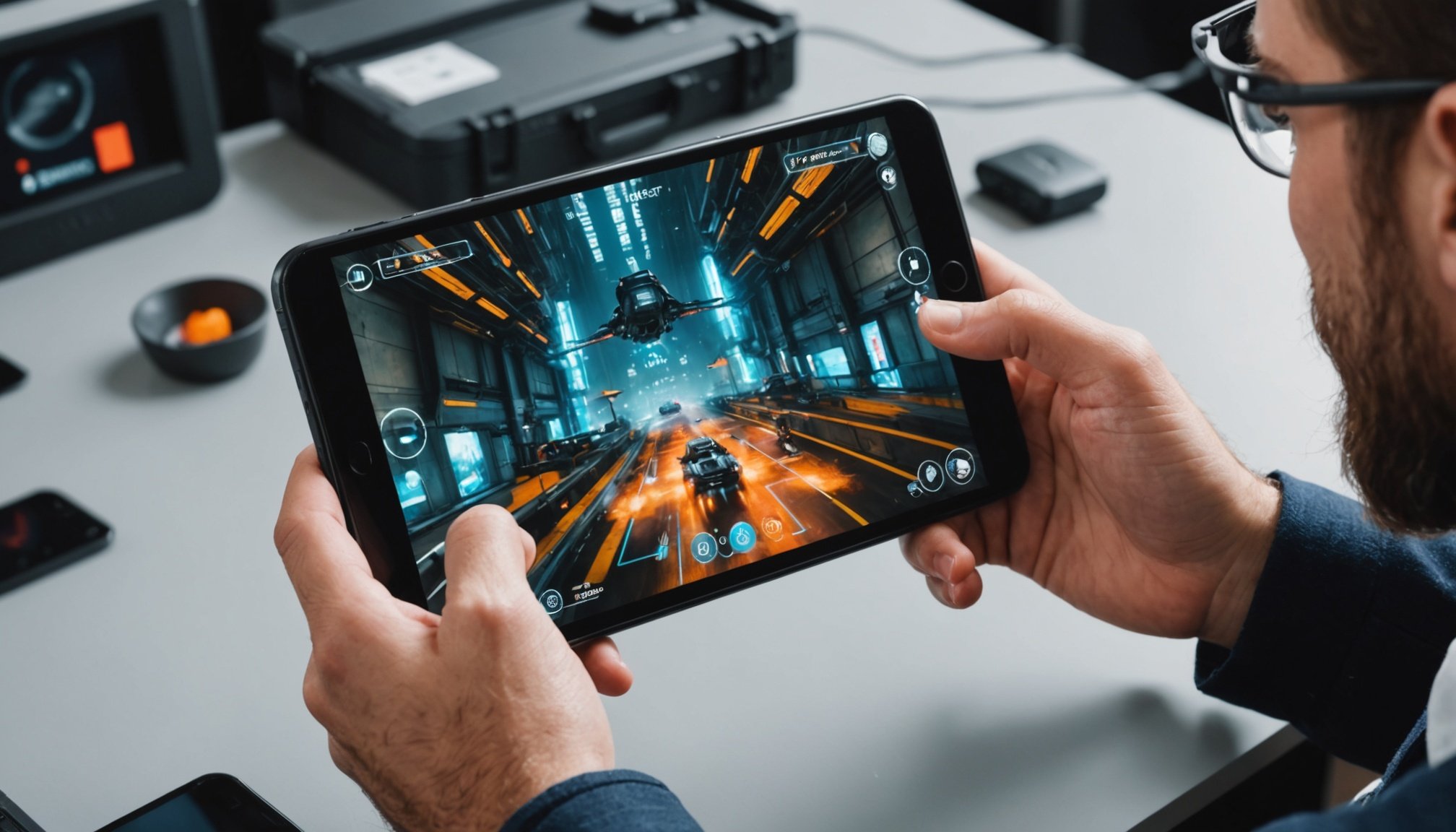Overview of Haptic Feedback in Mobile AR Games
Haptic feedback has transformed the world of mobile augmented reality (AR) gaming, acting as a bridge between the virtual and physical realms. By providing tactile responses, it enhances the immersion players experience, making them feel more connected to the digital environment. This sensory mechanism is essential, as it allows players to “feel” actions and interactions, boosting user experience.
In recent trends, mobile AR games have increasingly incorporated diverse gaming technology to captivate users. The role of seamless user experience stands central here, drawing players deeper into the game narrative. Haptic feedback serves as a crucial component, as it offers real-time tactile cues—like vibrations when a character encounters obstacles—adding layers of realism.
This might interest you : Revving up realism: how real-time ray tracing transforms reflections in racing games
Modern mobile devices boast impressive technical capabilities that facilitate sophisticated haptic feedback. Most smartphones today possess advanced vibration motors and sensors that can execute nuanced vibrations, providing varied tactile sensations. These advancements in gaming technology enable developers to design more intricate AR experiences, further engaging users with multi-sensory feedback loops.
Overall, the integration of haptic feedback into mobile AR is not just an enhancement, but a necessity for a fully immersive user experience. As technology progresses, we can expect even richer interactions driven by tactile feedback.
In parallel : Mastering realistic traffic generation in urban simulation games: proven strategies for authentic experiences
Challenges in Integrating Haptic Feedback
Integrating haptic feedback in gaming presents distinctive technical challenges. A primary concern is the limitations of existing mobile hardware. The performance of haptic feedback is highly reliant on the device’s hardware capabilities. These limitations can affect the strength and responsiveness of the feedback, reducing the overall immersive experience.
Design obstacles also play a significant role in effective integration. Developers must find a balance between feedback intensity and responsiveness while ensuring seamless gameplay. If haptic feedback is too intense or delayed, it can become distracting or even disrupt the gaming experience. Techniques involving careful calibration can enhance the gameplay without overwhelming the player.
User perception of haptic feedback is another crucial element. Understanding how different users perceive and react to haptic cues in gameplay is vital. Each user may experience haptic feedback differently, depending on their personal preferences and expectations. Thus, user testing and feedback are essential in refining these features.
Designers and developers face the intricate task of addressing these challenges to maximise user perception and enjoyment. By focusing on enhancing technical performance and aligning with user expectations, the haptic feedback in games and applications can be improved and widely accepted.
Effective Design Strategies
Incorporating haptic feedback into game mechanics involves analysing best practices to create an immersive experience. One effective strategy is to integrate haptic cues that complement on-screen actions, thus enhancing the user interface and providing gamers with a more intuitive interaction. This involves synchronising vibrations with gaming events such as scoring a point or encountering obstacles, which can significantly improve user engagement.
When designing user interfaces for haptic interactions, it is crucial to focus on simplicity and ease of use. An intuitive interface can effectively guide users through complex game mechanics, making the experience seamless. For instance, using minimalistic visual cues that correspond with haptic feedback can make it easier for players to quickly comprehend the game’s dynamics and respond accordingly.
Iterative testing and feedback from users are vital during the design phase to ensure the efficacy of these design strategies. By involving end-users in testing, developers can gather insights into how haptic feedback is perceived and make necessary adjustments before the final release. This approach helps in refining the user interface and ensures that the final design meets user expectations and enhances the overall gaming experience. Regular updates based on user feedback can maintain continuous improvement of haptic elements.
Technical Implementation of Haptic Feedback
In the realm of augmented reality (AR), haptic feedback offers a tactile engagement, enriching user experiences through sensory stimulation. The successful integration of haptic feedback revolves around proficient use of Software Development Kits (SDKs). Popular frameworks like Unity’s Haptic Plugin and Android’s Native Haptic Feedback SDK provide developers with the tools necessary to seamlessly embed tactile elements into AR applications.
Integration techniques are critical to the nuanced application of haptic feedback in AR environments. Begin by selecting an appropriate SDK that aligns with your project requirements. Incorporate the SDK through your development platform’s package manager and configure the haptic parameters to fit the desired output. Ensure synchronization between visual and tactile outputs, enhancing the immersive experience.
However, implementing haptic feedback can present challenges. Common troubleshooting issues include latency between the visual and haptic signal or inconsistent feedback strength. To address these, verify your SDK’s calibration settings and connectivity with the development platform. Testing each component rigorously helps identify discrepancies promptly.
Through diligent application of technical implementation strategies, developers can effectively integrate haptic feedback, ensuring a more engaging user interface in AR products. By understanding the available tools and adhering to integration protocols, practitioners enhance interactivity, fostering a more dynamic virtual experience.
Case Studies of Successful AR Games with Haptic Feedback
Exploring case studies of augmented reality (AR) games reveals successful integration of haptic feedback, enhancing the user experience. This section will focus on specific mobile AR games that effectively use this technology, offering immersive and engaging gameplay.
One notable example is “Pokémon Go.” It integrates haptic feedback to alert players of nearby Pokémon, creating a more interactive experience. This subtle vibration ensures players remain engaged even when the visual and auditory signals are not prominent.
In another case, “Harry Potter: Wizards Unite” creatively uses haptic feedback during spellcasting sequences, where users feel vibrations corresponding to spell energy. This tactile response has received positive user feedback for its immersive qualities and was praised for making the game feel more interactive.
User feedback from these games frequently highlights the enhanced immersion and enjoyment provided by haptic technology. Players appreciate the additional layer of interaction, noting that it improves focus and engagement during gameplay.
Performance metrics indicate that haptic feedback can significantly boost player retention and satisfaction. Games utilizing it effectively often report higher engagement times and repeat play sessions.
Lessons learned from these studies emphasize the importance of non-intrusive, meaningful haptic feedback to enhance player experience without overwhelming them, showing a pathway for future developments in AR gaming.
Expert Opinions on Future Trends
In the rapidly evolving world of augmented reality (AR) games, industry insights reveal exciting possibilities for haptic feedback innovations. According to expert analysis, future trends indicate a significant revolution in how users engage with mobile gaming experiences.
Perspectives from Industry Experts: One consensus among leading technologists is that haptic feedback could soon provide more immersive and tactile experiences. By incorporating advanced sensory technology, AR games might allow users to physically “feel” actions and environments, bridging the gap between virtual and real-world experiences.
Potential Advancements in Technology: Numerous advancements, such as more sophisticated actuator technology and refined sensory algorithms, are expected to enhance these haptic experiences. Experts are optimistic that these technological breakthroughs will lead to more precise and realistic feedback, making interactions feel more intuitive and engaging.
Predictions for Transformation: As haptic feedback technology evolves, predictions suggest it will fundamentally transform user interactions within mobile gaming. Gamers might soon experience enhanced emotional connections and deeper immersion, thanks to real-time, responsive feedback systems. This evolution could set new standards for game design, focusing more on multisensory engagement to captivate players more effectively.
As the field progresses, these future trends promise to redefine the boundaries of AR gaming, offering exhilarating new experiences for users worldwide.






